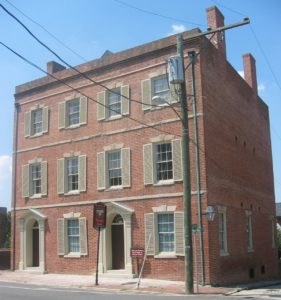 Built in 1817, the Farmers’ Bank in Petersburg is one of the oldest bank buildings in the United States. The building resulted from the action of the General Assembly on February 13, 1812, that established the “Farmers’ Bank of Virginia” in Richmond. The bank subsequently established branch banks in Lynchburg, Norfolk, Petersburg, and Winchester, each with its own capital stock. By the time the Civil War began, additional branches had been opened in Alexandria, Clarksville, Danville, Fincastle, Front Royal, Harrisonburg, Jeffersonville, Lewisburg, Newbern, and Salem. Unlike modern banks, each of these individual banks issued its own bank notes. The gold standard governing financial operations in the United States at that time allowed for the bank notes to be redeemed in gold.
Built in 1817, the Farmers’ Bank in Petersburg is one of the oldest bank buildings in the United States. The building resulted from the action of the General Assembly on February 13, 1812, that established the “Farmers’ Bank of Virginia” in Richmond. The bank subsequently established branch banks in Lynchburg, Norfolk, Petersburg, and Winchester, each with its own capital stock. By the time the Civil War began, additional branches had been opened in Alexandria, Clarksville, Danville, Fincastle, Front Royal, Harrisonburg, Jeffersonville, Lewisburg, Newbern, and Salem. Unlike modern banks, each of these individual banks issued its own bank notes. The gold standard governing financial operations in the United States at that time allowed for the bank notes to be redeemed in gold.
In 1812, the Petersburg branch of the Farmers’ Bank opened in an unknown location that presumably was destroyed in the great Petersburg fire of July 16, 1815. On January 23, 1816, the bank bought the lot on the northwest corner of Bollingbrook Street and Market Lane (now Cockade Alley) from Robert Bolling for $7,000 as the site for a new bank building. Robert Bolling was a wealthy and prominent Petersburg citizen, and the Bollings were the most important family in the early history of Petersburg. He served as a captain in the Continental Army during the Revolutionary War and built Centre Hill Mansion in 1823.
The new bank building was located in the busiest commercial district in Petersburg. On November 8, 1817, the Mutual Assurance Society of Virginia insured a “Banking house of Brick, three stories high covered with slate with a parapit [sic] wall all around” for $18,000. The policy also covered four brick outbuildings: a stable and carriage house; a two-story, 38-foot by 20-foot kitchen; a smokehouse; and a “Guard house.” The bank building was a four-bay brick structure that was three-stories high and measured 44-feet by 46-feet. At either end of the building were interior chimneys. The façade and east wall were laid in Flemish bond, and the rear and west walls were laid in three-course American bond. The windows on the façade and east wall were decorated with sandstone sills and carved keystones. Banking operations took place on the first floor; the upper floors were used by the managing cashier of the bank as his residence. Today, the second-floor woodwork is almost totally from the period of construction “and ranks among the handsomest Federal woodwork in Petersburg.” The third floor also contains much of its original woodwork.
By the 1850s, the Exchange Bank and the Bank of Virginia also operated in Petersburg. The Farmers’ Bank in 1860 had capital totaling $270,000. It invested in Confederate bonds during the Civil War, and as a result it was not solvent after the war ended.
In 1866, the General Assembly mandated that all state banks be liquidated. On June 25, 1867, the appointed trustees of the Farmers’ Bank’s assets sold the bank and its buildings to John Patterson Branch for $5,000. According to Branch’s obituary, which appeared in the February 3, 1915, edition of the New York Times, he was born in Petersburg in 1830, served as an officer in the Confederate Army of Northern Virginia during the Civil War, and surrendered with that army at Appomattox Court House, Virginia, in April of 1865. He was the President of Merchants’ National Bank, served on the Executive Committee of the American Bankers Association, and was a philanthropist. His father was Thomas Branch, who was a Petersburg merchant, mayor, and Unionist member of the Virginia Secession Convention representing Petersburg.
John O’Connor bought the bank property in 1879 for $3,002, and operated a grocery and liquor business in the building until 1896. In 1962, John D. Haire of Petersburg bought the property and subsequently conveyed it to the Association for the Preservation of Virginia Antiquities (APVA). In 1966, the Fort Henry Branch of the APVA (now known as Preservation Virginia) purchased the building, and its acquisition was a catalyst for historic preservation in that area of the city.
The Farmers’ Bank has been restored to the time of the Early Republic, c. 1820-1840. In the rear of the building are an herb garden and a restored kitchen. Visitors can see the heavy safe, which was in the cashier’s office on the first floor during business hours but was lowered into the vault below at night. The press (on loan from Preservation Virginia) and plates used to print the currency issued by the bank are on display. Inside the bank is a collection of antique furniture, including a Boston tall-case clock with an imprinted label of Paul Revere, a settee, and several chairs. The Petersburg Visitors’ Center currently is located inside the building and is open from 9 am to 5 pm Monday through Saturday and from 1 to 5 pm on Sunday. Winter hours are from 9 am to 4 pm Tuesday through Saturday, 12 pm to 4 pm on Sunday, and the center is closed on Monday.